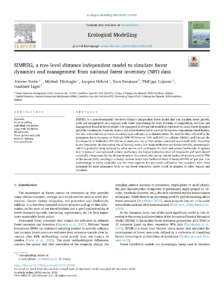
Perin J., Pitchugin M., Hébert J., Brostaux Y., Lejeune P., Ligot G. [2021] SIMREG, a tree-level distance-independent model to simulate forest dynamics and management from national forest inventory (NFI) data. Ecological Modelling 440(1):109382
Abstract : SIMREG is a non-deterministic tree-level distance independent forest model that can simulate forest growth, yield and management on a regional scale while representing the wide diversity of composition, structure and management found in forest stands. It is composed of several sub-models to represent the main forest dynamics (growth, recruitment, removal, clearcut and reforestation) and to account for species composition, stand density, tree size and social status, forest ownership type and some sites characteristics. We used the data collected by the permanent forest inventory of Wallonia (IPRFW) between 1994 and 2015 to calibrate SIMREG and forecast the development of Wallonia’s 479 500 ha of productive forest (465 million simulated trees) until 2050. According to our simulation, the harvesting rate of Norway spruce (the main production species) is currently unsustainable and it is gradually being replaced by other species such as Douglas-fir, larch and various hardwoods. It appears that in terms of total softwood volume production, the higher production level of Douglas-fir and larch should eventually compensate for the decline in spruce. In contrast, the harvest rate in hardwood stands is around 75% of the annual yield, resulting in a steady increase in the total hardwood stock of about 600 000 m³ per year. Our methodology is easily replicable and the data required for sub-model calibration are consistent with those measured by most permanent NFIs, so our forest simulation model could be adapted to other regions and countries.
Consultez la notice complète de l’article sur ORBi
